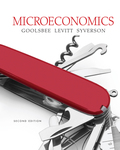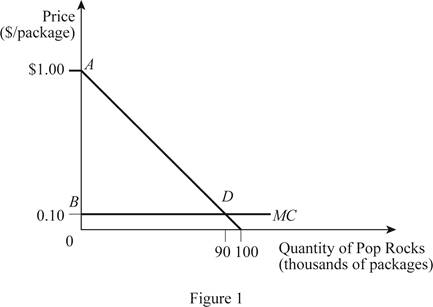
(a)
The competitive
(a)
Explanation of Solution
The competitive price in the given situation is equal to the marginal cost. Thus, the competitive price is $0.10 per package. The inverse demand function can be calculated using Equation (1) as follows:
The quantity can be calculated by substituting the value of price in Equation (1) as follows:
Thus, the competitive quantity is 90.
(b)
The
(b)
Explanation of Solution
Figure 1 shows the price and quantity of packages.

The horizontal axis of Figure 1 measures the quantity of packages and the vertical axis measures the price.
The
Thus, the consumer surplus is $40.50.
In the given situation, the
Consumer Surplus: Consumer surplus is defined as the difference between the maximum amount a person is willing to pay for consuming a commodity and the actual price the person pays for it.
Producer Surplus: Producer surplus is defined as the difference between the actual market price for which a commodity is sold and the minimum cost at which a producer is willing to sell a commodity. This minimum accepted price is usually the cost of production of the commodity.
(c)
The
(c)
Explanation of Solution
The marginal revenue can be calculated as follows in Equation.
The marginal revenue function is
Given that the marginal cost is $0.10 and the marginal revenue is
The profit of a firm is maximized when marginal revenue is equal to the marginal cost.
The profit is maximized when the quantity of output produced is 45.
The price charged by the monopolist to maximize the profit can be calculated by substituting the value of profit maximizing output in Equation (1).
Thus, the profit maximizing output is 45 and the profit maximizing price is $0.55.
Profit: Profit is defined as the excess revenue earned over the total cost of production.
(d)
The consumer surplus and producer surplus.
(d)
Explanation of Solution
The new consumer surplus can be calculated as follows:
Thus, the consumer surplus is $10.125.
The producer surplus can be calculated as follows.
Thus, the producer surplus is $20.25.
Consumer Surplus: Consumer surplus is defined as the difference between the maximum amount a person is willing to pay for consuming a commodity and the actual price the person pays for it.
Producer Surplus: Producer surplus is defined as the difference between the actual market price for which a commodity is sold and the minimum cost at which the producer is willing to sell the commodity. This minimum accepted price is usually the cost of production of the commodity.
(e)
The
(e)
Explanation of Solution
The change in consumer surplus can be calculated as follows.
Consumer surplus is decreased by $30.375.
The change in producer surplus can be calculated as follows:
Producer surplus is increased by $20.25.
The dead weight loss can be calculated as the difference between the loss in consumer surplus and the gain in producer surplus.
Thus, the dead weight loss is $10.125.
Consumer Surplus: Consumer surplus is defined as the difference between the maximum amount a person is willing to pay for consuming a commodity and the actual price the person pays for it.
Producer Surplus: Producer surplus is defined as the difference between the actual market price for which a commodity is sold and the minimum cost at which the producer is willing to sell the commodity. This minimum accepted price is usually the cost of production of the commodity.
Deadweight loss: Deadweight loss is defined as the loss of the total consumer surplus and producer surplus due to overproduction or underproduction.
Want to see more full solutions like this?
Chapter 9 Solutions
EBK MICROECONOMICS
- Supply and demand functions show different relationship between the price and quantities suppliedand demanded. Explain the reason for that relation and provide one reference with your answer.arrow_forward13:53 APP 簸洛瞭對照 Vo 56 5G 48% 48% atheva.cc/index/index/index.html The Most Trusted, Secure, Fast, Reliable Cryptocurrency Exchange Get started with the easiest and most secure platform to buy, sell, trade, and earn Cryptocurrency Balance:0.00 Recharge Withdraw Message About us BTC/USDT ETH/USDT EOS/USDT 83241.12 1841.50 83241.12 +1.00% +0.08% +1.00% Operating norms Symbol Latest price 24hFluctuation B BTC/USDT 83241.12 +1.00% ETH/USDT 1841.50 +0.08% B BTC/USD illı 83241.12 +1.00% Home Markets Trade Record Mine О <arrow_forwardThe production function of a firm is described by the following equation Q=10,000L-3L2 where Lstands for the units of labour.a) Draw a graph for this equation. Use the quantity produced in the y-axis, and the units of labour inthe x-axis. b) What is the maximum production level? c) How many units of labour are needed at that point?arrow_forward
- what is change in TC / change in Q? and what would be an example?arrow_forwardhow to solve the attachment?arrow_forwardProblem 3-ABC Challenges: Attrition, Balance and ComplianceCan television inform people about public affairs? Political scientists Bethany Albertson and Adria Lawrence (2009) conducted an experiment in which they randomly assigned people to treatment and control groups to evaluate the effect of watching TV on a person’s information level. Those assigned to the treatment group were told to watch a specific television broadcast and were later asked questions related to what they watched. Those in the controlgroup were not shown the TV broadcast but were asked questions related to the material in the TV broadcast. The dataset contains the following variables: : Dummy variable which =1 if a person reads news and 0 otherwise. : interest in political affairs (not interested=1 to very interested=4) : years of education : female dummy variable (female=1; male=0) : family income in thousands of dollars : information level (low information level=1 to high information level=4) =1 if the…arrow_forward
- Problem 2-Experiments/Randomized Control Trial Suppose you are interested in studying the effect of academic counselling on the years it takes for a student to obtain an undergraduate degree. You conduct a randomized control trial to answer the question. You randomly assign 2500 individuals in a university in New York to receive academic counselling and 2500 students to not receive any academic counselling. a. Which people are a part of the treatment group and which people are a part of thecontrol group? b. What regression will you run? Define the variables where required. c. Suppose you estimate = -0.3. Interpret it. d. You test for balance using the variables mentioned in the table below. Based on the results do you think that the treatment and control group are balanced? If your answer is “yes” then explain why. If your answer is “no”, then explain why and mention how will you address the issue of imbalance. e. Suppose that some unmotivated students in the control group decided to…arrow_forwardHow to calculate total cost?arrow_forwardProblem 1-Experiments/Randomized Control TrialSuppose you are interested in studying the effect of being a part of the labor union on anindividual’s hourly wage.You collect data on 1000 people and run the following regression. where is a dummy variable which is equal t to 1 for people who are a part of labor union and0 for others. a. Suppose you estimate . Interpret b. Do you think is biased or unbiased? Explain. Now suppose you conduct a randomized control trial to answer the same question. Yourandomly assign some individuals to be a part of the labor union and others to not be a partof the labor union. The first step you take is to ensure that the randomization was donecorrectly. Then you estimate the following equation: =1 if the student is assigned to be a part of Labor Union=0 if the student is assigned to not be a part of Labor Union c. Why is it important to ensure that the randomization is done correctly? d. Name any two variables that you can use to test if Treatment and…arrow_forward

 Principles of Economics (12th Edition)EconomicsISBN:9780134078779Author:Karl E. Case, Ray C. Fair, Sharon E. OsterPublisher:PEARSON
Principles of Economics (12th Edition)EconomicsISBN:9780134078779Author:Karl E. Case, Ray C. Fair, Sharon E. OsterPublisher:PEARSON Engineering Economy (17th Edition)EconomicsISBN:9780134870069Author:William G. Sullivan, Elin M. Wicks, C. Patrick KoellingPublisher:PEARSON
Engineering Economy (17th Edition)EconomicsISBN:9780134870069Author:William G. Sullivan, Elin M. Wicks, C. Patrick KoellingPublisher:PEARSON Principles of Economics (MindTap Course List)EconomicsISBN:9781305585126Author:N. Gregory MankiwPublisher:Cengage Learning
Principles of Economics (MindTap Course List)EconomicsISBN:9781305585126Author:N. Gregory MankiwPublisher:Cengage Learning Managerial Economics: A Problem Solving ApproachEconomicsISBN:9781337106665Author:Luke M. Froeb, Brian T. McCann, Michael R. Ward, Mike ShorPublisher:Cengage Learning
Managerial Economics: A Problem Solving ApproachEconomicsISBN:9781337106665Author:Luke M. Froeb, Brian T. McCann, Michael R. Ward, Mike ShorPublisher:Cengage Learning Managerial Economics & Business Strategy (Mcgraw-...EconomicsISBN:9781259290619Author:Michael Baye, Jeff PrincePublisher:McGraw-Hill Education
Managerial Economics & Business Strategy (Mcgraw-...EconomicsISBN:9781259290619Author:Michael Baye, Jeff PrincePublisher:McGraw-Hill Education





